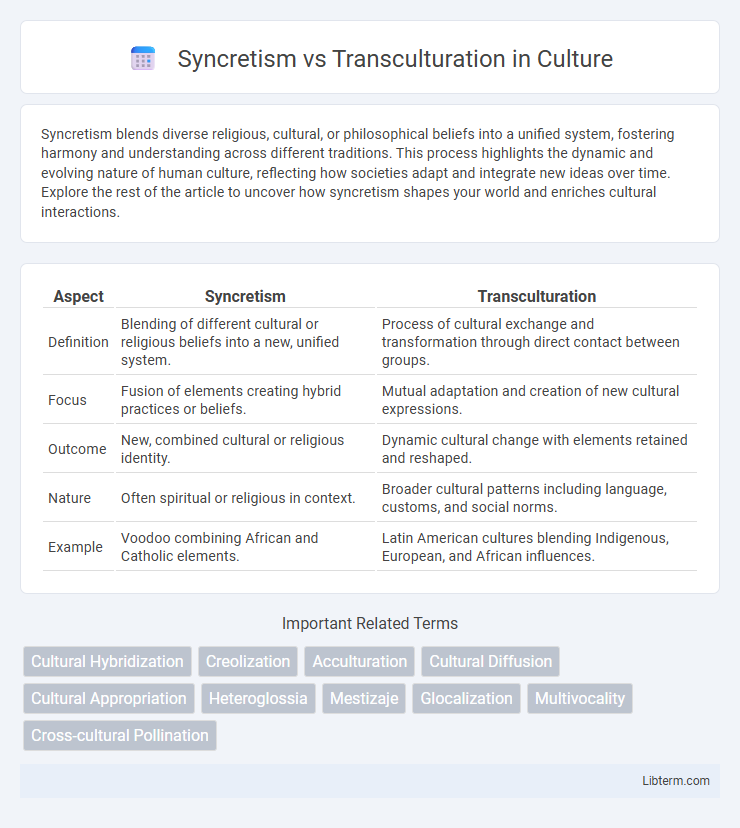Syncretism blends diverse religious, cultural, or philosophical beliefs into a unified system, fostering harmony and understanding across different traditions. This process highlights the dynamic and evolving nature of human culture, reflecting how societies adapt and integrate new ideas over time. Explore the rest of the article to uncover how syncretism shapes your world and enriches cultural interactions.
Table of Comparison
| Aspect | Syncretism | Transculturation |
|---|---|---|
| Definition | Blending of different cultural or religious beliefs into a new, unified system. | Process of cultural exchange and transformation through direct contact between groups. |
| Focus | Fusion of elements creating hybrid practices or beliefs. | Mutual adaptation and creation of new cultural expressions. |
| Outcome | New, combined cultural or religious identity. | Dynamic cultural change with elements retained and reshaped. |
| Nature | Often spiritual or religious in context. | Broader cultural patterns including language, customs, and social norms. |
| Example | Voodoo combining African and Catholic elements. | Latin American cultures blending Indigenous, European, and African influences. |
Understanding Syncretism: Definition and Origins
Syncretism refers to the blending of different religious, cultural, or philosophical beliefs to create a new system, often emerging from colonial encounters and cultural exchanges throughout history. Its origins trace back to the interaction between indigenous traditions and foreign influences, such as the fusion of African, European, and Indigenous American elements during the colonial period. Understanding syncretism involves recognizing the adaptive and integrative processes that form hybrid cultural expressions, reflecting both resistance and assimilation in multi-ethnic societies.
Exploring Transculturation: Meaning and Development
Transculturation refers to the complex process through which cultures interact, merge, and transform through continuous exchange and adaptation of cultural traits, leading to the creation of new, hybrid cultural expressions. It emphasizes an active, reciprocal cultural evolution rather than mere blending or superficial fusion seen in syncretism. This concept was developed by Cuban anthropologist Fernando Ortiz in the early 20th century to describe the dynamic, multidirectional growth of cultural identities within colonized societies.
Key Differences Between Syncretism and Transculturation
Syncretism involves the blending of different religious or cultural beliefs into a new, cohesive system, often maintaining elements from both original sources. Transculturation emphasizes the exchange and adaptation of cultural traits between groups, resulting in new cultural expressions without necessarily merging beliefs. The key difference lies in syncretism's fusion of ideologies, while transculturation highlights mutual cultural transformation and coexistence.
Historical Examples of Syncretism
Historical examples of syncretism include the blending of Greek and Egyptian religious practices in Hellenistic Egypt, where deities like Serapis combined attributes of Osiris and Zeus. Another key instance is the Roman adoption of Greek gods, merging characteristics to create hybrid deities such as Jupiter-Ammon. Syncretism also shaped early Christian traditions by integrating pagan rituals and symbols to ease the spread of Christianity in the Roman Empire.
Notable Cases of Transculturation in History
Notable cases of transculturation include the blending of African, Indigenous, and Spanish cultures in Latin America during the colonial era, resulting in unique languages, religions, and customs such as Afro-Brazilian Candomble and Mexican Mestizo identities. Another significant example is the cultural fusion in the Caribbean, where African, European, and Indigenous influences created distinctive music genres like reggae and calypso. The Philippines also exemplifies transculturation through its Spanish colonial history blended with native Austronesian traditions, producing hybrid religious practices and festivals.
Syncretism in Religion and Spiritual Practices
Syncretism in religion refers to the blending of different religious beliefs and practices into a cohesive system, often resulting in new rituals, deities, or theological concepts. This process is evident in historical contexts such as the fusion of African spiritual traditions with Christianity in Afro-Caribbean religions like Santeria, where Yoruba deities are equated with Catholic saints. Syncretism facilitates cultural adaptation and continuity, allowing spiritual practices to evolve while preserving core elements from multiple faiths.
Transculturation in Language and Communication
Transculturation in language and communication involves the blending and merging of linguistic elements from different cultures, resulting in new dialects, hybrid languages, and enriched expressive forms. This process fosters mutual understanding and cultural exchange by integrating diverse vocabularies, idioms, and communication styles, enhancing cross-cultural interaction. Unlike syncretism, which often merges elements into a unified whole, transculturation emphasizes dynamic, bidirectional linguistic transformations that preserve distinct cultural identities within communication.
Sociocultural Impacts of Syncretism
Syncretism profoundly shapes sociocultural landscapes by blending diverse religious, linguistic, and cultural elements, fostering hybrid identities and communal cohesion. This process often leads to the creation of new traditions that reflect shared values while preserving distinct heritage aspects, enhancing social integration in multicultural societies. The dynamic interactions resulting from syncretism can challenge rigid cultural boundaries, promoting tolerance and intercultural dialogue.
The Role of Power Dynamics in Transculturation
Power dynamics shape transculturation by influencing how dominant cultures impose or negotiate their values, customs, and social structures over subordinate groups. Unlike syncretism, which often implies peaceful blending, transculturation involves complex power relations that result in selective adoption, resistance, and reinterpretation of cultural elements. This process reflects asymmetrical interactions where cultural exchange is intertwined with colonialism, political authority, and economic control, impacting identity formation and social hierarchies.
Contemporary Relevance: Syncretism vs Transculturation
Syncretism and transculturation shape contemporary cultural identities by blending diverse beliefs and practices into new, hybrid forms that challenge traditional boundaries. Syncretism involves merging elements from different religions or cultures, often creating unified yet complex systems, while transculturation emphasizes the bidirectional exchange and transformation between cultures, highlighting negotiation and adaptation. Both processes are crucial in understanding globalization's impact on cultural expression, social integration, and identity politics in multicultural societies.
Syncretism Infographic

 libterm.com
libterm.com